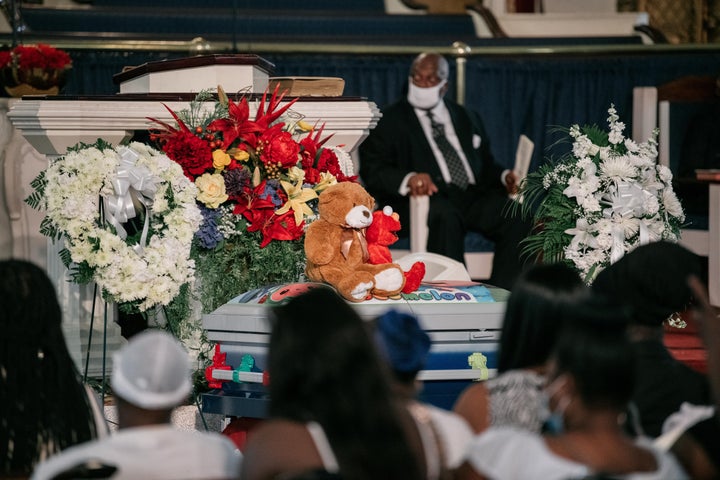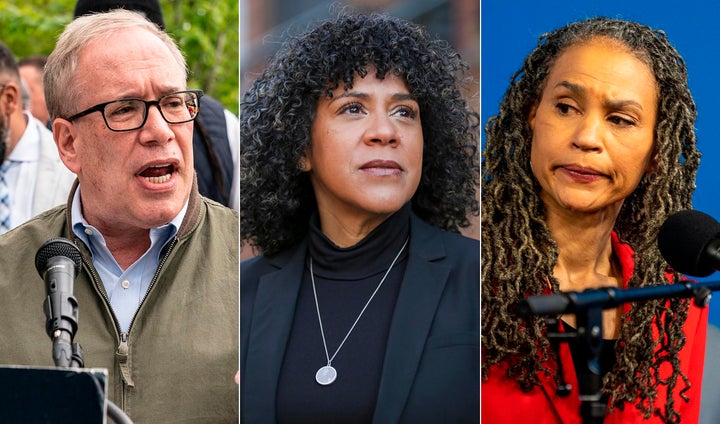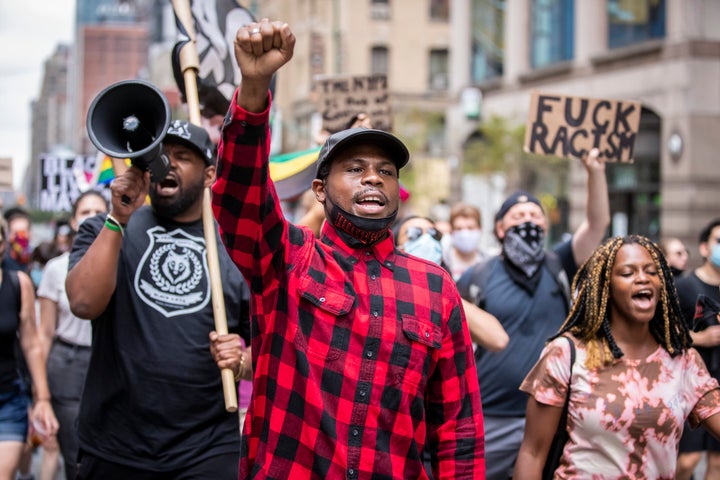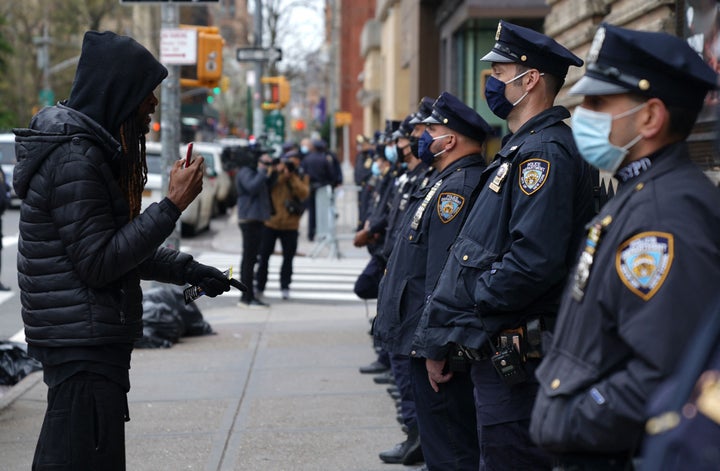How A Historic Spike In Crime Upended New York City Politics
On a particularly violent weekend last July, a group of young men who had been engaged in a dispute with members of a rival gang shot up a cookout in Bedford-Stuyvesant, Brooklyn. The gunfire wounded three young men and killed a 1-year-old boy, Davell Gardner Jr.
Gardner’s death embodied the tragic toll of the current, historic surge in violent crime in New York City.
Overall, shootings in the nation’s largest city rose by 97% from 2019 to 2020; murders rose by 45% over the same period. The carnage has persisted well into 2021, with the city experiencing 50% more murders than at this time two years ago.
The crime wave has hit New York City’s low-income Black and Latino neighborhoods especially hard.
But it has occasionally spilled into middle-class areas and tourist haunts. Incidents like a daytime execution-style murder in Park Slope, the crossfire wounding of three tourists in Times Square and the gang rape of a man walking through Central Park at night have all evoked an era of lawlessness and insecurity that New Yorkers thought was a thing of the past.
Although homicides and other acts of violence remain a fraction of what they were at their peak in the early 1990s, the sharp pace of the rise in incidents has scrambled the politics of the crowded race for New York City mayor.
Public safety is now the top issue in the Democratic primary on June 22 ― a contest all but certain to decide the general election winner.
The centrality of crime has largely benefited the field’s more moderate candidates, delivering a jolt of reactionary energy to a city whose politics had been shifting to the left for years.
“Whether it’s real or perceived, when people feel like crime is increasing, voters tend to become more conservative in their likes,” said Christina Greer, a political scientist at Fordham University and co-host of the New York City politics podcast “FAQ NYC.”
The competition among mayoral contenders over who has the best short-term answers to the uptick in crime has come as a relief for New Yorkers who believe that more police and tougher punishments are needed to stem the tide of violence.
But it’s also a source of concern for progressives who fear that politicians’ desire to control City Hall could undo years of progress on police and criminal justice reform without reducing crime over the long term.
“I am concerned because it seems like candidates are feeding that fear,” said New York City Public Advocate Jumaane Williams, a progressive Democrat who has not endorsed anyone in the mayoral race. “People are more concerned about elections than actually addressing the issue.”
Referring to former President Donald Trump, Williams added, “This nation has just gone past, nationally, a candidate feeding fear. It just is not a healthy thing to do.”
It’s telling, for example, that Brooklyn Borough President Eric Adams and former presidential candidate Andrew Yang, the two front-runners, have been in something of a battle for the tough-on-crime mantle.
After the May 8 shooting in Times Square, Yang, who has at times cultivated an air of ideological ambiguity, abandoned all pretense, attacking calls to “defund the police.”
“The truth is that New York City cannot afford to defund the police,” Yang said. “When I talk to New Yorkers, I get a very different message every single day.”
Although the two men have similar platforms ― including putting more cops in subway stations and reconstituting the city’s plainclothes anti-crime unit ― only Adams, a former police captain and the leading Black candidate in the field, has made improving policing the centerpiece of his candidacy from the start.
Responding to Yang’s remarks in Times Square, Adams, who is promising to be a “blue-collar mayor,” accused Yang of expressing concern about crime only when it began affecting tourist areas and middle-class neighborhoods.
“It took a shooting in Andrew Yang’s backyard for him to wake up and discover there was a crime problem and to stand up to gun violence,” he said.
Adams’s characterization of Yang is not entirely accurate. Among other things, Yang promised to address violent crime when he announced his race, and he laid out a blueprint for public safety in the New York Daily News in February.
But Adams’s deep roots in, and relationships with, the low-income and working-class Black and Latino communities in Brooklyn, Queens and the Bronx have helped him secure the endorsement of the United Clergy Commission, or UCC. The UCC is an influential group of more than 100 Black and Latino Christian ministers who have united to fight the violent crime plaguing the communities they serve.
“The community is incensed with the crime. It’s hurting. Kids can’t go out to play in the park,” UCC President Gerald Seabrooks, bishop of the Rehoboth Cathedral in Bedford-Stuyvesant, told HuffPost, the anger obvious in his voice. “We want to be treated like any other community, and we want the police to do their job.”
For her part, former city sanitation commissioner Kathryn Garcia, who is casting herself as a competent turn-around specialist, has called for devoting more New York Police Department resources to tackling gun violence and increasing the city’s gun buy-back rebate amount from $200 per gun to $2,000.
“It will begin with the NYPD, and I intend to give them the resources they need to protect New Yorkers and prosecute gun violence,” Garcia said at a May 11 news conference, a day after receiving the New York Times editorial board endorsement.
Meanwhile, the main progressive contenders in the race, after spending years cultivating the activist left and endorsing calls for funding cuts, have been forced to campaign on the terms of the crime hawks.
Rather than set the terms of the debate and put moderates on the defensive to explain their plans to address homelessness, mental health problems and other phenomena that the left believes are root causes of crime, the left-leaning candidates have been at pains to burnish their public safety credentials without abandoning their base.
To that end, city Comptroller Scott Stringer and Maya Wiley, the former counselor to Mayor Bill de Blasio, have both tried to argue that there is no tradeoff between public safety and greater police accountability.
In addition to allocating more police resources toward homicide detectives, Stringer would send more mental health professionals into the subways, rather than cops, and make a violence interruption program available in more city neighborhoods. He has emphasized that having grown up in Manhattan in the 1970s, he is aware of how devastating crime can be to the fabric of the city.
“We’ve got to keep our city safe, but we can’t over-police Black and brown kids,” he told reporters May 9 while campaigning outside the Fairway supermarket on Manhattan’s Upper West Side.
Wiley is still calling for cutting $1 billion from the NYPD’s $6 billion budget and devoting the savings to social programs and other crime prevention initiatives. (Wiley’s campaign did not clarify whether her cuts would come on top of the $420 million in existing cuts to the NYPD budget approved before the start of the fiscal year.)
Among other things, Wiley would expand the city’s summer job programs to provide 5,000 jobs to at-risk youth. She calls the idea of a zero-sum contest between public safety and police accountability a “false choice.”
“I have been Black all my life,” Wiley, who would be the city’s first Black woman mayor, said at the May 13 mayoral debate. “And that means I know two things: I know what it’s like to fear crime, and I know what it’s like to fear police violence.”
Of course, Wiley, who is married to media investor Harlan Mandel, has a modest layer of extra protection in her upscale Prospect Park South neighborhood.
Neighborhood households each pay $550 a year to fund a private security car that patrols the tree-lined streets of the tony enclave. Wiley told the New York Daily News that she thinks the private security car is “ridiculous,” but she allows her family to contribute as a marital compromise. After being brutally mugged while walking in the neighborhood in 2001, Wiley’s husband, Mandel, had to be hospitalized and miss work for six weeks.
Dianne Morales, a former nonprofit executive who attracted the enthusiasm of the activist left before her campaign melted down this week amid accusations of staff union busting, comes the closest to capturing the radical spirit of the protesters demanding that the city “defund the police” in the summer of 2020.
Morales, who would also be the city’s first Black woman mayor and first Latina mayor, wants to halve the NYPD budget, remove cops from schools and traffic enforcement, and use the $3 billion in savings to tackle homelessness and poverty.
“It’s time for us to address and focus on the systems, not the symptoms,” she said at the May 13 mayoral debate.
Notwithstanding the clear distinctions between the progressive and moderate Democratic candidates on questions of public safety, the ranked-choice voting system being used in NYC mayoral elections for the first time this cycle has complicated the electoral calculus for candidates across the ideological spectrum.
Even leading contenders are wary of alienating other candidate’s supporters, just in case there might be a few of those voters willing to list them as a second, third, fourth or fifth choice.
The votes are counted in five rounds. In each round, the worst-performing candidate is eliminated, and that candidate’s voters are redistributed to those voters’ next-ranked choice. The winning candidate is the first person to reach a majority of votes through this multi-round elimination system.
Sean Dugar, the education campaign program director for Rank the Vote, which encourages cities to adopt ranked-choice voting, argued that the system has already decreased some of the negativity in the mayoral race. Independent groups supporting candidates have been more likely to go negative than the candidates themselves, he said.
“We are definitely seeing a change in the tone of elections overall,” he said.
That’s perhaps why Adams has toned down some of his more over-the-top rhetoric criticizing left-wing activists in recent weeks. In late April, Adams disparagingly said that “young, affluent white people” led the movement to “defund” the NYPD.
But when Morales pressed Adams on the remarks at a May 13 debate, saying that she had worked alongside plenty of Black proponents of “defund,” Adams hedged.
“It was the ‘disband’ movement that I was speaking of, not the ‘defund’ movement … the movement to disband police departments across the country,” Adams said, citing as an example the ongoing far-left riots and vandalism in Portland, Oregon.
In an interview a few days earlier, Adams told HuffPost that he supports progressive efforts to prevent crime through peaceful intervention and economic empowerment, over the long term, but that in the near term, New Yorkers need more cops in trouble spots and faster 911 response times to stop the violence.
“We must have intervention and prevention,” he said. “Many people only want the prevention, but while you prevent issues you must deal with the imminent threat and danger.”
The debate between New York’s Democratic candidates reflects broader philosophical disagreements about public safety in the advocacy and academic worlds.
Candidates like Morales tend to focus exclusively on how economic deprivation and disinvestment might be pushing young people in low-income neighborhoods toward a life of crime.
Other progressives, when asked about the reason for the crime spike ― a wave sweeping cities across the country ― point to the social isolation, unemployment and public service cutbacks wrought by the COVID-19 pandemic.
“In 2019, we had historically low numbers of murders and gun violence,” Williams said. “The primary difference between 2019 and 2021 is a global pandemic. There’s a lot of folks who just want to ignore that.”
But more centrist and conservative thinkers maintain that humans are prone to act out absent consequences imposed by the state and that violence flourishes when those consequences deteriorate.
Bishop Seabrooks noted that the vast majority of his neighbors were lawful citizens, in spite of their poverty.
“The law is for the lawless,” Seabrooks said. “These individuals need to be punished.”
Then, among proponents of the idea that policing can and should deter people from committing crimes, there is a disagreement over why that deterrent has deteriorated so dramatically over the past two years.
Peter Moskos, a sociologist at John Jay College of Criminal Justice in Manhattan, believes, based on conversations with numerous NYPD officers, including participants in focus groups, that many police officers have decided that the personal risks of proactive policing are too great.
It’s the result of a combination of laws exposing police officers to greater legal liability for excessive force, and a hostile media and cultural environment that contributes to a sense that cops can have their lives upended by a viral video, even in the course of conducting themselves lawfully, according to Moskos.
“Discretionary policing basically ended,” said Moskos, who served a year in the Baltimore police force as part of his doctoral research. “Cops basically do a cost-benefit analysis: Is the juice worth the squeeze?”
As evidence of the decline in police morale, Moskos noted that 72% more NYPD officers retired in 2020 than in 2019, thinning the police force’s ranks to its lowest level in years even as violent crime skyrocketed in the city.
Richard Rosenfeld, a criminologist at the University of Missouri, St. Louis, is more skeptical of police claims that public hostility is preventing them from doing their jobs. Rosenfeld co-authored a May 2020 study refuting the existence of a so-called Ferguson Effect ― or the idea that social unrest and anti-police sentiment following the 2014 police killing of Michael Brown prompted police to stop doing their jobs.
The deterioration of community trust in police forces caused, at least in part, by police misconduct is much more likely to lead to a breakdown of cooperation with law enforcement and street-level justice than the phenomenon of “de-policing,” according to Rosenfeld’s interpretation of the available research.
To the extent that a triage solution is needed, data show that “precision policing” which places a surge of patrol officers in a handful of flashpoint neighborhoods can effectively deter crime, Rosenfeld said.
“It’s got to be done with a minimum of violence ― and no unwarranted police violence,” he said.
Regardless of their individual philosophies, control of City Hall could well hinge on the Democratic mayoral contenders’ success convincing the public that they have the right principles, expertise and experience to restore public safety.
Polling has shown that crime is either the highest or second-highest concern ― after COVID-19 ― for New York City voters.
Progressives insist that their more holistic, nuanced approaches to fighting crime will get traction with voters if left-leaning politicians have the courage to articulate them.
“Folks on the left can’t ignore this gun violence issue,” Williams said. “There has to be a better, stronger, emphatic response to it.”
“Candidates can say, ‘I am the candidate for public safety and here’s what that means’ and just break it down,” he added. “Last year, you can’t increase police officers while cutting all of the summer youth jobs and think that it doesn’t have an impact.”
Williams also said candidates should speak about coordinating with other cities and states to crack down on illegal gun sales.
But at campaign stops made by Yang, Adams and Stringer in Brooklyn and Manhattan earlier this month, the voters who were most outspoken about public safety advocated for traditional law-and-order solutions.
At a town hall meeting with voters at a church in Brooklyn Heights on May 8, the first question for Yang was from a woman demanding to know whether he would increase the size of, and funding for, the NYPD (she was supportive of the idea).
Yang said he was open to it, but “my first move is to see what we can do with our existing 36,000 officers to try and address some of these problems, because I’m convinced we can do more.”
Arnold Larkins, a Black retiree on the Upper West Side, greeted Stringer warmly when he saw him outside the Fairway on May 9. He told HuffPost that he is backing Stringer because of his familiarity with the comptroller.
Asked what his top issue was, Larkins said it was reducing crime.
“Every day I look at the paper, I turn on the news ― I’m seeing these shootings. Something’s wrong with that. That’s got to stop,” Larkins said. “And then, if you want to reform the police department, you can do that.”
Source: Read Full Article






